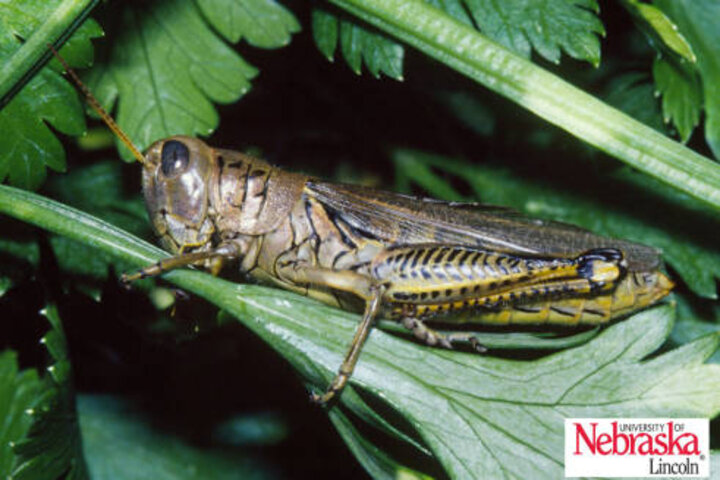Control is Easier in Borders and More Successful in the Immature Stages
Populations of immature grasshoppers are being reported in areas bordering crop fields in several parts of Nebraska. If these grasshopper species are one of the four major species that are likely to infest cropland, control may be warranted. These insects will likely continue to be a problem for the rest of the summer.
If they are abundant, it's best to try to control grasshoppers while they are concentrated in the border areas before they spread into the crops and before they become adults and become harder to control.
Only four of the more than 100 species of grasshoppers found in Nebraska normally damage field crops. These species are the
- twostriped,
- redlegged,
- differential, and
- migratory grasshoppers.
(For a detailed guide on identifying these four species see Grasshopper Identification Guide for Cropland Grasshoppers Summer Feeding Species, EC1569.) These species feed on a wide range of plants and are most often found in mixed habitats that include broadleaf weeds.
Because grasshoppers move into cropland generally from untilled areas surrounding crop fields, scout and, if necessary, treat these adjacent untilled areas first. Sometimes grasshoppers may hatch out from eggs laid in no-till crop fields as well. If grasshoppers have already invaded the field, also sample field areas to determine if control is warranted. The grasshoppers are most likely to move from these areas to adjoining crops when their food supply in these borders dries up or the borders are mowed.

Scouting
Estimating grasshopper densities is difficult and can only be done accurately with some practice. The best method for field borders or hatching areas is the square-foot method.
Randomly select an area several feet away and visualize a one-square-foot area around that spot. Walk toward this spot while watching this square foot area and count the number of grasshoppers you see in or jumping out of this area. Repeat this procedure 18 times and divide the total number of grasshoppers by two. This will give you the number of grasshoppers per square yard (9 square feet). Counting sites should be chosen at random and include varied vegetation.
To sample for grasshopper densities within fields — where grasshopper density will be lower — use the same method except visualize and count the hoppers in a square yard area. Because of the difficulty of seeing hoppers in this larger area, counts will be somewhat less accurate. Take 18 samples. Average these estimates to get the number of grasshoppers per square yard. When the number of grasshoppers per square yard has been estimated, use Table 1 to determine the potential need for treatment.
| Grasshopper Population | Within Fields | Field Borders | Treatment Necessary? |
|---|---|---|---|
| Non-economic | 0-2 | 10-May | No |
| Light | 7-Mar | 20-Nov | Uncertain — depends on size, species, type of crop |
| Moderate | 14-Aug | 20-40 | Probably |
Control Measures
Grasshoppers are easiest to control before they become adults and have fully developed wings (Figure 1). Numerous insecticides are labeled and effective for grasshopper control on various crops. (See the Insecticide Table for the respective crop, excerpted from Nebraska Extension EC130.) After grasshoppers become adults control success will be much more variable. If a range of rates is listed for a given insecticide, generally it's best to use the higher rates once adults are present. Always follow the recommended label rates, application directions, and restrictions.
Because grasshoppers do not like to enter dense plant canopies, most damage will be limited to field edges. Border treatments often are used to protect cropland from grasshoppers. A border spray should be effective for at least 7-14 days, depending on re-infestation pressure. Also, the residual activity of the treatments will vary with chemical and environmental conditions. It is important to monitor the border areas and crop margins after treatment to make sure grasshoppers do not reenter the field. Be sure to read and follow harvest and grazing restrictions when spraying borders adjoining cropland.

When treating borders, it is often necessary to treat the edge of the crop to reduce hopper numbers that have already moved into the field margin. One of the biggest problems with these treatments is that only a few insecticides are labeled for both crops and the surrounding areas (rangeland/pasture or non-crop areas).
Insecticides
Malathion and carbaryl are labeled on most crops along with range/pasture and non-crop areas, but these products are less effective on mature grasshoppers. Acephate (e.g., Orthene) is labeled for non-crop use, but the only crop it is labeled for is dry beans. Dimilin is labeled for range/pasture and non-crop use, but it's only additional label is on soybeans, and it is only active against immature grasshoppers. One advantage of Dimilin as a border spray would be the lowered impact on natural enemies, especially those effective on spider mites.
Perhaps the best products for this type of treatment are esfenvalerate (e.g., Asana) and lambda-cyhalothrin (e.g., Warrior), because they are labeled for non-crop use and for use on several crops (corn, soybeans, sugar beets, dry beans, sunflowers, potatoes). Mustang MAX is labeled for grass forage/fodder/hay crops and also can be used on field corn, seed corn, popcorn, alfalfa, sunflower, sorghum, soybeans and wheat. Numerous other products are specifically labeled for grasshopper control on various crops (http://entomology.unl.edu/fldcrops/pestipm.shtml).
For More Information
The UNL Department of Entomology's website, Grasshoppers of Nebraska, provides links to publications on grasshopper identification and control in crops, range, yards, and gardens, as well as to the book, Grasshoppers of Nebraska, a field guide to the many species of grasshoppers living in the state.

